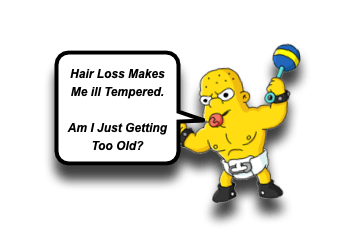Alopecia

Hair loss may not seem like an Emergency to you… but it is! (Ok… maybe my perspective has changed as I’ve aged.) Seriously though, Alopecia will certainly catch a parent’s attention and they may just come to the ED for answers. Not that you need to have all of the answers pertaining to Alopecia, but let’s take a minute to ensure we have a useful perspective of Alopecia affecting Children:
Alopecia: Basics
- Hair consists of shaft and root, which is anchored in the hair follicle. [Xu, 2017]
- Hair follicles contain rapidly dividing cells.
- Hair follicles can produce different types of hair over their lifespan: [Atton, 1990]
- Lanugo (soft hair newborns have)
- Vellus (downy, fine hair that replaces lanugo)
- Terminal Hair (thicker, pigmented hair)
- Every day 50-150 hairs fall out normally. [Xu, 2017]
- Terminal Hair goes through 3 growth phases: [Xu, 2017]
- Anagen phase – active growth, 90% of hair
- Catagen phase – brief involutionary phase
- Telogen phase – dormancy, 5-10% of hair is in telogenic phase
- Hair falls out after 2-3 months of telogen phase… and the cycle repeats.
- Hair loss can occur due to any disturbance in the development of a hair.
- Alopecia can occur in isolation or as a part of a multisystem syndrome. [Xu, 2017; Atton, 1990]
- Nutrition and diet play a role (ex, Eating Disorders)
- Autoimmune disorders (ex, Hashimoto Thyroiditis, Inflammatory Bowel Diseases).
- Endocrine disorders (ex, Diabetes)
- Atopic disorders
Alopecia: Considerations
- Alopecia is due to heterogenous etiologies. [Xu, 2017; Atton, 1990]
- Pediatric Alopecia is typically related to different causes than in adults. [Xu, 2017]
- Majority of pediatric alopecia is due to acquired causes.
- Although, it can even be present at birth (ex, aplasia cutis congenita).
- The common causes of Alopecia in children that should be considered: [Xu, 2017; Atton, 1990]
- Tinea Capitis
- Commonly due to Trichophyton tonsurans or Microsporum canis.
- Microsporum species deposit a product that is fluorescent under UV light.
- Trichophyton does NOT fluoresce and can produce lots of scaling and can be confused with seborrheic dermatitis.
- Initially not scarring, but can lead to Kerion, which due to its local inflammatory reaction, can be scarring.
- See broken hairs (i.e., Black Dot sign), scaling, erythema, and posterior cervical lymphadenopathy.
- Commonly due to Trichophyton tonsurans or Microsporum canis.
- Alopecia Areata
- Common form of autoimmune alopecia.
- May have family history or personal history of other autoimmune disorders, like vitiligo or thyroid disease.
- Typically has patchy hair loss that is well demarcated.
- Has positive Hair Pull Test.
- Trauma related:
- Traction Alopecia
- Due to constant tensile force on scalp from certain hairstyles (ex, braids, ponytails, tight buns, cornrows, etc).
- Usually does not scar, but can if allowed to go one too long.
- Trichotillomania
- Associated with impulse control issues.
- Non-scarring alopecia with patches of hair loss with irregular borders and hairs of various lengths.
- Usually not including the occipital area (more painful to pull hair from this region.
- Traction Alopecia
- Hair Cycle Disturbances
- Telogen Effluvium – abnormal amount of hairs in the telogen phase leading to increased shedding and diffuse thinning without scale.
- Anagen Effluvium – Rapid hair loss due to radiation/chemotherapy or malnutrition.
- Transient Neonatal Hair Loss
- Often concerning for first time parents, but is benign and common.
- Occurs in first two months of life.
- Previously thought to be due to friction of scalp on bedding, but this is unclear.
- Numerous other odd and interesting causes that would delight a dermatologist (but that I can’t truly comprehend).
- Tinea Capitis
- Physical Exam can help distinguish etiologies: [Xu, 2017]
- Look closely at scalp, lashes, dentition, and nails.
- Try the Tug Test and Pull Test. [Xu, 2017]
- Tug Test
- Attempt to fracture the hair shaft… is the hair fragile?
- Grasp the base of the hair and then tug the distal end with the other hand.
- Pull Test
- Gently pull a bundle of 20-60 hairs from multiple locations.
- Positive Test if >10% are pulled out.
- Tug Test
Moral of the Morsel
- Hair loss is not funny. (Stop laughing at me people!)
- Alopecia in Pediatric patients is often acquired. Look closely for clues and have a low threshold for covering for fungal infection.
- Hair Loss is not always simple. Think about related disorders and consider thyroid testing.
References
Landis ET1, Pichardo-Geisinger RO1. Methotrexate for the treatment of pediatric alopecia areata. J Dermatolog Treat. 2018 Mar;29(2):145-148. PMID: 28627278. [PubMed] [Read by QxMD]
Wu SZ1, Wang S2, Ratnaparkhi R2, Bergfeld WF3. Treatment of pediatric alopecia areata with anthralin: A retrospective study of 37 patients. Pediatr Dermatol. 2018 Nov;35(6):817-820. PMID: 30338548. [PubMed] [Read by QxMD]
Bernardis E1, Nukpezah J2, Li P3, Christensen T4, Castelo-Soccio L1. Pediatric severity of alopecia tool. Pediatr Dermatol. 2018 Jan;35(1):e68-e69. PMID: 29105836. [PubMed] [Read by QxMD]
Castelo-Soccio L1, McMahon P1. Pediatric Dermatology. J Clin Aesthet Dermatol. 2017 Mar;10(3):S8-S15. PMID: 28360970. [PubMed] [Read by QxMD]
Patel D1,2, Li P3, Bauer AJ4,5, Castelo-Soccio L1. Screening Guidelines for Thyroid Function in Children With Alopecia Areata. JAMA Dermatol. 2017 Dec 1;153(12):1307-1310. PMID: 28973128. [PubMed] [Read by QxMD]
Xu L1, Liu KX1, Senna MM2. A Practical Approach to the Diagnosis and Management of Hair Loss in Children and Adolescents. Front Med (Lausanne). 2017 Jul 24;4:112. PMID: 28791288. [PubMed] [Read by QxMD]
El-Taweel AE1, El-Esawy F1, Abdel-Salam O1. Different trichoscopic features of tinea capitis and alopecia areata in pediatric patients. Dermatol Res Pract. 2014;2014:848763. PMID: 25024698. [PubMed] [Read by QxMD]
Atton AV1, Tunnessen WW Jr. Alopecia in children: the most common causes. Pediatr Rev. 1990 Jul;12(1):25-30. PMID: 2194176. [PubMed] [Read by QxMD]

